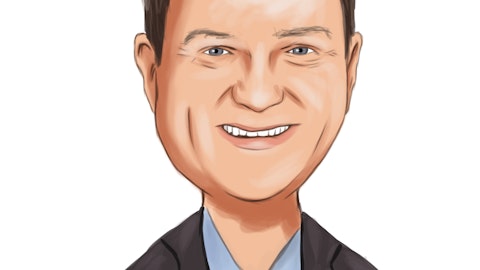Sheila Kahyaoglu: Perfect. That’s super helpful. And maybe one last one, if you don’t mind, Matt, you said on Critical Infrastructure, $10 million was the positive event in Q3. So, as we think about margins there, they’ve obviously been at a lower 5.5% in Q2 and kind of fluctuating around, how do you think we best sort of think about that for ’24?
Matt Ofilos: Yeah. Great question, Sheila. I think our goal is, of course, to get this first challenge program behind us this year. It’s still scheduled to wrap up in Q4. So, that will be a nice tailwind for us. I think from a guidance perspective, at Investor Day, we talked about 20 to 30 basis points, so somewhere in the 8.8% to 8.9%. The majority of that, as we’ve talked about before, will come from CI. So if you think of Federal still in the low 9%s, call it, 9.1% to 9.3%, the math on CI would be kind of mid-8%. So, I feel like the business is heading in the right direction. The backlog performance is performing at accretive margins. And so, we’re getting some of these challenges behind us.
Sheila Kahyaoglu: Perfect. Thank you.
Matt Ofilos: Thanks, Sheila.
Carey Smith: Thank you.
Operator: [Operator Instructions] The next question comes from Mariana Perez Mora with Bank of America. Your line is open.
Mariana Perez Mora: So, my question is going to be a follow-up on M&A. How is the pipeline? How are the — how is the pricing environment and competitiveness for those deals? Because you usually have acquired companies that you’re really close in, and I was interested to learn details about like how that pipeline is looking?
Carey Smith: Thanks, Mariana. The pipeline is very strong in both Federal and Critical Infrastructure. I mean we’re really pleased that we’ve been able to close the three acquisitions we’ve been able to do this year. We’re always kind of ranking and restacking that pipeline to end which one is most important based on the financial criteria of greater than 10% topline growth, greater than 10% EBITDA. And then looking at the technological differentiators, particularly on the Federal side, how do we continue to strengthen in cyberspace in missile defense and critical infrastructure protection. And on the infrastructure side, how do we double down in geographies that are going to be very important across the United States, but also considering Canada.
We’ve been able to continue to find terrific companies and are really glad to welcome them to the Parsons’ portfolio. We’ve also been able to do this mostly on a preemptive basis, so we try to avoid auctions. That’s enabled us to stick within our standard multiples of about a 10 times to 13 times. The most recent one we did with I.S. Engineers was 7.7 times multiple. So, we’re really pleased with the terrific companies we’ve been able to buy and the multiples we’ve been able to buy them at.
Mariana Perez Mora: As you expose yourselves to the infrastructure bill across the U.S. and with the recent Texas acquisition, what other states do you think you have opportunity to tap in or will be interested to double down?
Carey Smith: Yeah. So when you look at a lot of funds in the infrastructure bill, 70% of those come out through what’s called formula funds. And those are generally based on the population of states and their growth over time. So, it tends to be the larger states that get the money. Parsons is fortunate. We’re positioned in all 50 states, but we’ve set in place a list of Tier 1 states. They include states like California, New York, Florida and Texas, for example, that are expected to gain quite a bit of infrastructure bill funds.
Mariana Perez Mora: Thank you. And last one also related to this topic. How you think about buying the companies versus doing joint ventures when you approach those opportunities?
Carey Smith: So I’d say, first, we look at, are we going to build by our partner. So it’s, do we build it internal, and can we do that under a research and development and capital expenditures and get there in the timeframe that is needed to deliver our customers’ mission? Second, we look at should we partner as an area that is core to our company and if it’s not core, then we’ll go to a partnership route. And then third is, if it’s a core area of our company, we do a gap analysis. And we specifically outlined what technologies we need to be able to continue to move up the solutions integration value chain and be able to bid and win in prime larger contracts. So that’s kind of our standard criteria. From a joint venture, I would say, while we do joint ventures, we’ve started to reduce the number of joint ventures that we do. We will only joint venture in instances where a customer really wants that or where it’s required for past performance to win a contract.
Operator: This is all the time that we have for questions. I would now like to turn the call back to Dave Spille for closing remarks.
Dave Spille: Thank you for joining us this morning. If you have any questions, please don’t hesitate to give me a call. And we look forward to speaking with many of you over the coming weeks. And with that, we’ll end today’s call. Thank you very much.
Operator: This concludes today’s conference call. Thank you for participating. You may now disconnect.
Follow Parsons Corp (NYSE:PSN)
Follow Parsons Corp (NYSE:PSN)
Receive real-time insider trading and news alerts



